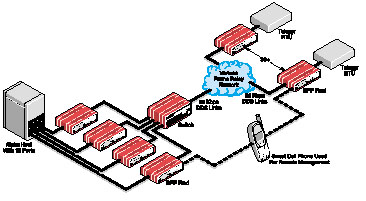Management Interface Makes Life Easier for Communications Tester
“I’ve been able to live a somewhat normal life due to the frame relay equipment.” So says Eric Heldt who is responsible for maintaining the SCADA network at Erie Boulevard Hydropower, recently acquired by Reliant Energy. Erie Boulevard Hydropower was previously owned by Orion Power who merged with Reliant Energy in Early 2002.
In addition to his responsibilities for the successful operation of the SCADA network at Erie Boulevard Hydropower, Eric also has a family and coaches youth hockey. He has found that the reliability and ease of management of the SCADA network, now that much of it has been moved over to frame relay, makes it possible for him to “live a normal life” while being on call 24 hours a day, 7 days a week.
“I can get a trouble call while I am out on the ice with the kids and not have to run around looking for a phone where I can plug in my laptop.” says Eric. “Besides searching for a phone, I would end up being away from the kids for 20 or 30 minutes. Now I can just dial up with my cell phone and check the error information and other information on the FRADs. In most cases it just takes a few minutes to isolate a problem.”
The frame relay network is much easier to diagnose than the older analog modem systems. The frame relay equipment Eric manages has simple, short menu commands that make remote management convenient…even when using a palm computer via cell phone. The frame relay access devices, or FRADs, contain diagnostic commands and activity counters that make tracking down a problem fast and reliable.
Detailed management information is available, such as characters transmitted and received, errors due to framing, and other causes, as well as network packets transmitted or received and errors. Frame relay network information is also available to assist the phone company in diagnosing their network.
Since frame relay is more reliable than analog networks, one would expect it to be more costly. Exactly the opposite is true… Frame relay connections are usually priced much less than similar, but much slower analog connections. The standard for frame relay connections is a 56 or 64 Kbps line…compared to 9.6 or even 2.4 Kbps for an analog multi-point line.
The FRADs in use at Erie Boulevard Hydropower also enable the 56 Kbps frame relay network to be used for older, legacy 9.6 kbps and slower SCADA equipment regardless of the protocol in use. The FRADs support all common SCADA protocols as well as special, proprietary asynchronous and synchronous protocols. Erie Boulevard Hydropower uses multiple port models at the host site to allow multiple SCADA RTUs to communicate over the same frame relay network, regardless of their protocols and speeds. This simplifies the communications infrastructure when converting from legacy to newer RTU equipment.
Polling SCADA protocols are in use at Erie Boulevard Hydropower and the FRADs are specially designed to support the polling process. The polling information destined for specific RTU drops is directed to the remote RTU drop(s) by the host site FRAD. The host FRAD sends the polling data to a list of DLCI’s (frame relay network addresses) programmed into the FRAD by Erie Boulevard Hydropower.
To remotely manage the network, Eric uses a smart cell phone with Palm software, capable of text based data communications. “Of all the ideas I’ve had to do things, this has proven to be the best.” The frame relay equipment he is using has a simple and compact text interface that works very well with the limited text screen of the cell phone. Eric can be out on the ice practicing with the kids and use his cell phone to quickly isolate problems and dispatch the appropriate service.
The terminal software in his cell phone makes it possible to manage the frame relay access devices (FRADs) from anywhere. The FRADs can be queried as to traffic volume, status, error rates, configuration, can be reset, and more.
Equipment Used in the System
The ERIE BOULEVARD HYDROPOWER SCADA system uses 16 frame relay lines and the DNP protocol to communicate with a Compaq Alpha host computer system. The sixteen I/O ports connect to Telegyr 5700 Station Managers. The frame relay connections run through FRADs over the Verizon frame relay network. Eric says that the frame relay network has “unbelievable reliability compared to analog.”
Eric chose frame relay due to its increased reliability vs. analog, the ability to multi-drop for polling SCADA equipment with minimum latency, and the additional security it adds.
The FRADs are available with password security features, built-in redundancy via back-up host sites, and optional dial-network backup. The security feature was a necessity for this system.
Eric says the FRAD diagnostics are especially useful because telecom equipment at the substations is isolated from the phone line with Positron protection equipment. This defeats the usual current reversal DDS loop back used for diagnostics by the telephone company. Since those tests are not functional, an in-band loop back within the FRAD comes in handy for Telco troubleshooting. For example, there was a newly installed drop with continuing problems. Verizon relied on the FRAD error stats to determine the 56 kbps loop was bad. Verizon replaced the 56 kbps DDS loop with a 64 Kbps private line ISDN loop to correct the problem.
Eric already uses an Access Switch and dial up modem for management of multiple devices at the host location. The Access Switch is capable of allowing management of from 4 to 152 devices from one network or dial up connection. This eliminates the need for multiple modems or dedicated PCs at Reliant’s host site. Any device with an RS232 management interface, in addition to the FRADs, can be connected to the Access Switch.
Future enhancements for Eric's network include automatic dial-up backup for important sites. They are also looking at multiple PVC features that allow a single SCADA network to be polled by both a T&D as well as a Generator organization. That would eliminate the duplicated SCADA equipment and associated monthly costs common in the deregulated power industry where two or more organizations need access to common data.
Since the frame relay network here has a 34 ms typical ping time, he is able to poll 16 circuits of 9600 bps over a single 56 kbps link with no delay problems. That is quite favorable when compared to an analog network.
When configured with redundant hosts, there is no “dead time” if a host site goes down. The switchover is automatic, since it's operating full-time through the frame relay network's multiple private virtual circuit features. No phone call to the telephone company is required, and no in-house manual switching is necessary.
Reliable and rapid response to polling, at last
Erie Boulevard Hydropower’s success in migrating to the frame relay network and improving the manageability of their SCADA network serves as a model example for electric energy SCADA users throughout the country. Through innovative networking solutions, all energy generators and distribution companies can help guarantee that customers will receive uninterrupted, economical service well into the future.
About the Author
Mr. Straayer is President of Data Comm for Business, Inc., a position he has held since founding the company in 1981. Prior to that, Mr. Straayer was Vice President of Compre Comm, Inc, from 1977 until 1981, and a manager with the State of Illinois Telecommunications Division from 1971 to 1977.
Mr. Straayer is a graduate of the University of Illinois Springfield with a degree in Communications. Mr. Straayer has consulted for major companies and has been an instructor in data communications courses.
“I’ve been able to live a somewhat normal life due to the frame relay equipment.” So says Eric Heldt who is responsible for maintaining the SCADA network at Erie Boulevard Hydropower, recently acquired by Reliant Energy. Erie Boulevard Hydropower was previously owned by Orion Power who merged with Reliant Energy in Early 2002.
In addition to his responsibilities for the successful operation of the SCADA network at Erie Boulevard Hydropower, Eric also has a family and coaches youth hockey. He has found that the reliability and ease of management of the SCADA network, now that much of it has been moved over to frame relay, makes it possible for him to “live a normal life” while being on call 24 hours a day, 7 days a week.
“I can get a trouble call while I am out on the ice with the kids and not have to run around looking for a phone where I can plug in my laptop.” says Eric. “Besides searching for a phone, I would end up being away from the kids for 20 or 30 minutes. Now I can just dial up with my cell phone and check the error information and other information on the FRADs. In most cases it just takes a few minutes to isolate a problem.”
The frame relay network is much easier to diagnose than the older analog modem systems. The frame relay equipment Eric manages has simple, short menu commands that make remote management convenient…even when using a palm computer via cell phone. The frame relay access devices, or FRADs, contain diagnostic commands and activity counters that make tracking down a problem fast and reliable.
Detailed management information is available, such as characters transmitted and received, errors due to framing, and other causes, as well as network packets transmitted or received and errors. Frame relay network information is also available to assist the phone company in diagnosing their network.

Since frame relay is more reliable than analog networks, one would expect it to be more costly. Exactly the opposite is true… Frame relay connections are usually priced much less than similar, but much slower analog connections. The standard for frame relay connections is a 56 or 64 Kbps line…compared to 9.6 or even 2.4 Kbps for an analog multi-point line.
The FRADs in use at Erie Boulevard Hydropower also enable the 56 Kbps frame relay network to be used for older, legacy 9.6 kbps and slower SCADA equipment regardless of the protocol in use. The FRADs support all common SCADA protocols as well as special, proprietary asynchronous and synchronous protocols. Erie Boulevard Hydropower uses multiple port models at the host site to allow multiple SCADA RTUs to communicate over the same frame relay network, regardless of their protocols and speeds. This simplifies the communications infrastructure when converting from legacy to newer RTU equipment.
Polling SCADA protocols are in use at Erie Boulevard Hydropower and the FRADs are specially designed to support the polling process. The polling information destined for specific RTU drops is directed to the remote RTU drop(s) by the host site FRAD. The host FRAD sends the polling data to a list of DLCI’s (frame relay network addresses) programmed into the FRAD by Erie Boulevard Hydropower.
To remotely manage the network, Eric uses a smart cell phone with Palm software, capable of text based data communications. “Of all the ideas I’ve had to do things, this has proven to be the best.” The frame relay equipment he is using has a simple and compact text interface that works very well with the limited text screen of the cell phone. Eric can be out on the ice practicing with the kids and use his cell phone to quickly isolate problems and dispatch the appropriate service.
The terminal software in his cell phone makes it possible to manage the frame relay access devices (FRADs) from anywhere. The FRADs can be queried as to traffic volume, status, error rates, configuration, can be reset, and more.
Equipment Used in the System
The ERIE BOULEVARD HYDROPOWER SCADA system uses 16 frame relay lines and the DNP protocol to communicate with a Compaq Alpha host computer system. The sixteen I/O ports connect to Telegyr 5700 Station Managers. The frame relay connections run through FRADs over the Verizon frame relay network. Eric says that the frame relay network has “unbelievable reliability compared to analog.”
Eric chose frame relay due to its increased reliability vs. analog, the ability to multi-drop for polling SCADA equipment with minimum latency, and the additional security it adds.
The FRADs are available with password security features, built-in redundancy via back-up host sites, and optional dial-network backup. The security feature was a necessity for this system.
Eric says the FRAD diagnostics are especially useful because telecom equipment at the substations is isolated from the phone line with Positron protection equipment. This defeats the usual current reversal DDS loop back used for diagnostics by the telephone company. Since those tests are not functional, an in-band loop back within the FRAD comes in handy for Telco troubleshooting. For example, there was a newly installed drop with continuing problems. Verizon relied on the FRAD error stats to determine the 56 kbps loop was bad. Verizon replaced the 56 kbps DDS loop with a 64 Kbps private line ISDN loop to correct the problem.
Eric already uses an Access Switch and dial up modem for management of multiple devices at the host location. The Access Switch is capable of allowing management of from 4 to 152 devices from one network or dial up connection. This eliminates the need for multiple modems or dedicated PCs at Reliant’s host site. Any device with an RS232 management interface, in addition to the FRADs, can be connected to the Access Switch.
Future enhancements for Eric's network include automatic dial-up backup for important sites. They are also looking at multiple PVC features that allow a single SCADA network to be polled by both a T&D as well as a Generator organization. That would eliminate the duplicated SCADA equipment and associated monthly costs common in the deregulated power industry where two or more organizations need access to common data.
Since the frame relay network here has a 34 ms typical ping time, he is able to poll 16 circuits of 9600 bps over a single 56 kbps link with no delay problems. That is quite favorable when compared to an analog network.
When configured with redundant hosts, there is no “dead time” if a host site goes down. The switchover is automatic, since it's operating full-time through the frame relay network's multiple private virtual circuit features. No phone call to the telephone company is required, and no in-house manual switching is necessary.
Reliable and rapid response to polling, at last
Erie Boulevard Hydropower’s success in migrating to the frame relay network and improving the manageability of their SCADA network serves as a model example for electric energy SCADA users throughout the country. Through innovative networking solutions, all energy generators and distribution companies can help guarantee that customers will receive uninterrupted, economical service well into the future.
About the Author
Mr. Straayer is President of Data Comm for Business, Inc., a position he has held since founding the company in 1981. Prior to that, Mr. Straayer was Vice President of Compre Comm, Inc, from 1977 until 1981, and a manager with the State of Illinois Telecommunications Division from 1971 to 1977.
Mr. Straayer is a graduate of the University of Illinois Springfield with a degree in Communications. Mr. Straayer has consulted for major companies and has been an instructor in data communications courses.








